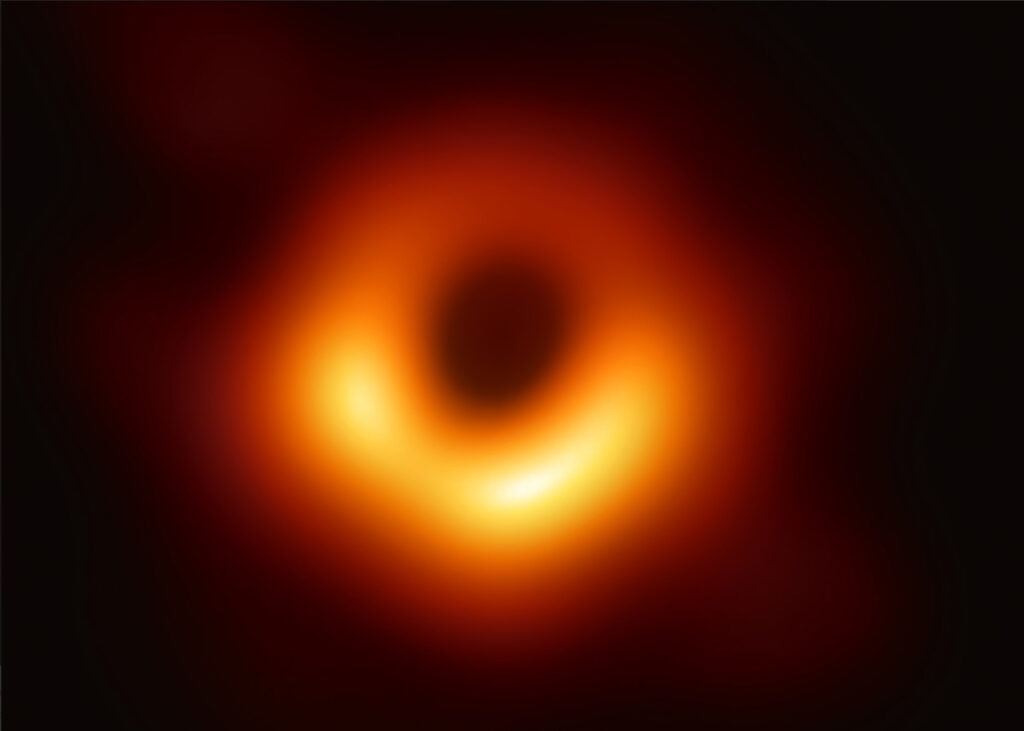
First Direct Image of a Black Hole
Black holes are regions of spacetime where gravity is so intense that nothing can escape, not even light. The boundary where the curvature of spacetime inevitably leads into the black hole is known as the event horizon. Our knowledge of black holes stems from Albert Einstein’s general theory of relativity.
Theoretical Basis
The idea of an object so massive and dense that not even light can escape its gravitational pull dates back to 1783. English philosopher John Michell and French mathematician Pierre-Simon Laplace independently proposed the concept of “dark stars” with such strong gravitation that light could not escape them. But their ideas were incomplete and their significance was not recognized until Albert Einstein developed his theory of general relativity in 1915. Einstein’s theory provided the mathematical equations to understand how a gravitational field affects the curvature of space, time, and light.
In 1916, Karl Schwarzschild found an exact solution to Einstein’s field equation which described the gravitational field around a spherically symmetric, non-rotating mass. Schwarzschild’s solution revealed the existence of a critical radius within which the gravitational well is so steep that nothing can escape. This region has been called a black hole since John Wheeler coined the term in 1967.
Despite his theory’s prediction of black holes, Einstein was skeptical that such objects could exist. In a 1935 paper with Nathan Rosen, he stated: “For a singularity brings so much arbitrariness into the theory that it actually nullifies its laws…. Every field theory, in our opinion, must therefore adhere to the fundamental principle that singularities of the field are to be excluded.” Then, in 1939, he published a paper suggesting that black holes were impossible, believing that some unknown repulsive force would prevent their formation. A few months later, J. Robert Oppenheimer and Hartland Snyder described the formation of black holes through the gravitational collapse of massive stars based on general relativity. Subsequently, Einstein tacitly acknowledged the possibility of black holes, writing Oppenheimer, “The essential result of your investigation is a most brilliant scoop, which will be an epoch-making achievement in the problem of gravitation.”
Observational Evidence
Without empirical evidence, black holes remained a theoretical oddity for decades until the late 1960s, when the discovery of pulsars provided indirect evidence for their existence. The first came in 1971 with the discovery of Cygnus X-1, an X-ray source in the constellation Cygnus. Subsequent observations confirmed that Cygnus X-1 is a binary system containing a black hole with a mass estimated to be around 15 times that of the Sun. Since then, other black holes have been detected and studied, proving their existence and validating Einstein’s theory of general relativity.
Direct evidence of black holes came from the LIGO and Virgo collaborations in 2015 with the detection of gravitational waves by merging black holes, just as Einstein’s theory had predicted.
In 2019, the Event Horizon Telescope collaboration released the first direct image of a black hole’s event horizon in the galaxy M87, shown in the picture above. Currently, the James Webb Space Telescope (JWST) can observe black holes. This year, a central supermassive black hole was found in one of the most distant and youngest galaxies observed so far, and it is in an active phase of consuming matter.
Another significant discovery in 2024 by the JWST involves the galaxy CEERS 1019, which existed just over 570 million years after the Big Bang. This black hole is notable for its smaller size, approximately 9 million solar masses, compared to other early universe black holes. It is rapidly accreting gas and provides insights into the formation and growth of early black holes.
Most recently, as discussed in the previous blog, we have direct evidence of the “waterfall” or “plunging” region around a black hole about 10,000 light-years from Earth.
Astrophysicists believe there are hundreds of millions of stellar-mass black holes in our Milky Way galaxy. Throughout the observable universe, there are thought to be an estimated 100 billion supermassive black holes residing at the center of most, if not all, galaxies, with new stellar black holes forming every second.
Future Directions
The study of black holes is advancing rapidly. Some key directions include:
- Building new telescopes to create motion pictures of black holes.
- Detecting and studying more black hole mergers through gravitational wave observations.
- Improving imaging of the environment around black holes.
- Searching for primordial black holes, which may have a role in explaining dark matter and dark energy.
Summary
Albert Einstein did not live to see the evidence confirming the existence of black holes. His doubts that black holes were real reflected his discomfort with singularities and lack of evidence during his lifetime. Nevertheless, he created the groundwork with his general theory of relativity that has led to our current knowledge of these extreme distortions of spacetime.
